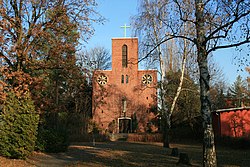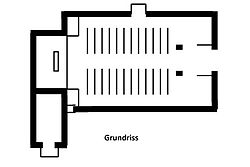St. Joseph (Berlin-Tegel)
| St. Joseph Church | |
|---|---|
|
Portal page |
|
| Start of building: | October 2, 1932 |
| Inauguration: | February 19, 1933 |
| Architect : | Joseph Bishop |
| Style elements : | Aftermath of the New Objectivity |
| Client: | Catholic parish Herz-Jesu |
| Dimensions: | 22 × 13 × 7 m |
| Space: | 260 people |
| Location: | 52 ° 35 '57.88 " N , 13 ° 17' 41.82" O |
| Address: | Bonifaziusstrasse 16-18 Berlin-Tegel Berlin , Germany |
| Purpose: | catholic worship |
| Local community: | Catholic parish Herz-Jesu |
| Diocese : | Archdiocese of Berlin |
| Website: | www.herz-jesu-tegel.de/st-joseph-tegel.html |
The Catholic St. Joseph Church ( ) is one of the three churches in the Catholic parish Herz-Jesu in the Berlin district of Tegel . In the forms of New Building it is limited to the function of the individual parts of the building and is a listed building
history
The People's Association for Catholic Germany founded on November 23, 1919 at the suggestion of Carl sunshine in Berlin, the Catholic savings and Siedlungsgenossenschaft St. Joseph eGmbH Their goal was to alleviate the housing shortage and to eliminate the housing shortage. In 1924 she began construction work in the Tegel-Nord area, where Bruno Taut's Freie Scholle was also created. In 1927 a building plot in the center of the settlement area was purchased by the Association of Catholic Churches in Greater Berlin from the settlement cooperative, on which the church was later built, the cost of which was to cost 70,000 Reichsmarks including the interior . Since it was not possible to build a church in the first years of the settlement's existence during the global economic crisis and the period of unemployment, it was decided to first set up an emergency church in an unused workshop , which was inaugurated on December 25, 1931.
The church was built in 1932/1933. After the groundbreaking ceremony on August 7, 1932 and the laying of the foundation stone by Cathedral Chapter Paul Weber on October 2, 1932, the church was consecrated on February 19, 1933 by Vicar General Paul Steinmann. On November 1, 1933, the parish of St. Joseph was established as a parish association with the Sacred Heart of Jesus, on July 1, 1939, St. Joseph received the status of a curate and on February 8, 1941 was elevated to an independent parish .
During an air raid on November 26, 1943 , the church ceiling collapsed, making a quick reconstruction impossible. Therefore the emergency church was restored and rededicated on July 23, 1944. In 1946 a barrack on the church property was converted into a chapel and sacristy . Only on December 17, 1950, the church was consecrated again after the reconstruction.
On June 30, 2004, the congregation returned to Herz Jesu and, through merging with the Herz-Jesu Church in Alt-Tegel as the parish church and St. Marien in Heiligensee, forms the Catholic parish Herz Jesu.
Building description
The architect Josef Bischof distanced himself with St. Joseph from his somewhat historicist churches St. Salvator in Lichtenrade and St. Alfons in Marienfelde . The simple hall church is a masonry structure that is faced with red bricks in a cross connection . The nave is covered with a gable roof. The rectangular, strongly drawn-in choir under the lower roof ridge has an extension for the sacristy. Under the choir, on the left, there is a small chapel with a baptismal font . The gallery for the organ is located above the entrance hall . The entrance side consists of a flat-roofed crossbar at the height of the roof ridge of the nave. The bell tower rises above the central part with high, arched sound arcades on each side. In the bell room hangs a bronze bell that was made in 1933 in the Otto bell foundry . It weighs around 300 kg, has a diameter of 80 and a height of 67 cm and bears the inscription REDEMPTOR NOSTER JESUS CHRIST VIA VERITAS ET VITA / SALVA NOS ET POST HOC EXILIUM DUC NOS IN VITAM AETERNAM. Otto delivered two bells in 1933. The other bell was melted down during World War II.
A sculpture of Joseph of Nazareth , the patron saint of the church, created by Josef Thorak , is located above the portal in the facade, which is framed with artificial stone . The nave has five high circular windows with a diameter of 160 cm on both sides. They contain the portraits of the four evangelists Matthew , Mark , Luke and John , the four church fathers Ambrose , Hieronymus , Augustine and Gregory the Great and the two apostles Peter and Paul . The crossbar has a large wheel window on each of the three sides . The side windows in the chancel show the depiction of the birth of Jesus .
The interior is provided with a wooden beam ceiling. In the width of the choir, the ceiling is the thickness of a beam higher, reminiscent of a basilica . The floor is covered with Solnhofen limestone . After the 2nd Vatican Council the sanctuary was redesigned. The high altar , communion bench and pulpit were dismantled. The tabernacle , previously on the high altar, is now supported by a pillar . In place of the former pulpit is an ambo made from the former communion bench. The new altar was adapted to the side altars, two red brick pillars support a plate. The two side altars are dedicated to the Mother of God and the Sacred Heart of Jesus .
On the occasion of the 25th anniversary of the church, the altar walls were decorated with new ceramic pictures instead of the destroyed sculptures . In 1952 a Joseph figure and in 1999 a new altar cross was purchased by Paul Brandenburg .
literature
- Christine Goetz and Matthias Hoffmann-Tauschwitz: Churches Berlin Potsdam. Berlin 2003.
- Architects and Engineers Association of Berlin: Berlin and its buildings. Part VI. Sacred buildings. Berlin 1997.
- Klaus-Dieter Wille: The bells of Berlin (West). History and inventory. Berlin 1987.
- Gerhard Streicher and Erika Drave: Berlin - city and church. Berlin 1980.
Web links
- Homepage of the parish of Tegel
- Entry in the Berlin State Monument List with further information
- Bond issued in 1930 by the savings and settlement cooperative St. Joseph eGmbH
Individual evidence
- ^ Gerhard Reinhold: Otto bells. Family and company history of the Otto bell foundry dynasty . Self-published, Essen 2019, ISBN 978-3-00-063109-2 , p. 588, especially page 538 .
- ↑ Gerhard Reinhold: Church bells - Christian world cultural heritage, illustrated using the example of the bell founder Otto, Hemelingen / Bremen . Nijmegen / NL 2019, p. 556, especially p. 497 , urn : nbn: nl: ui: 22-2066 / 204770 (dissertation at Radboud Universiteit Nijmegen).


